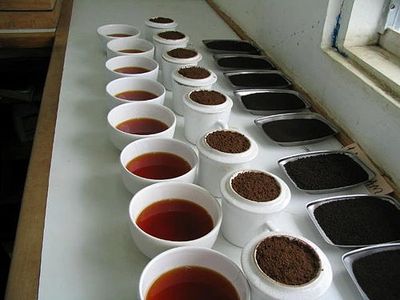How to find the perfect cup of coffee
Blending Instructions
Most people wander through life looking for the perfect cup of coffee. When asked most will say I like Dunkin Doughnuts or Starbucks. What you have done is tried lots of coffee until you found one you liked. I propose a different method, a more scientific method.
First why blend coffee, there are many reasons, it allows you to produce the same taste regardless of the availability of certain beans. Beans are the pit of the coffee cherry. Its a grown product and like all grown products the yield and taste vary based on growing conditions. Large producers have coffee blenders who know how to mix and match different coffees to produce that taste they are known for. They also blend for cost And lastly, they blend to produce something special.
Like wine, coffee is highly dependent on the growing conditions. There are two main types, arabica and robusta. Most of the coffee we drink is arabica so when it says 100% arabica its not telling you much. Robusta has more body, caffeine but its not known for its taste so its used where you are looking to say increase body but usually in very small amounts in artisan coffee.
Coffee plants like it hot so you find the main growing regions in you guessed it hot places.
There are some broad categories and general tastes below, as soon as I state something its wrong because it varies so much, even from farms next to each other.
I offer some broad categories of coffee that change from time to time Ill divide them into base and accents
Base Coffee, Suitable alone or as the largest part of a blend
Brazil Naturally Processed - A full body coffee, naturally processed means dried in the sun rather than soaked in tanks to get the outer cover off the pit. You need dry conditions during harvest time to naturally process so not all coffees are available in natural
Colombian - This is what many Americans think coffee tastes like, its kind of a plain Jane, good but not distinctive. But lots of people like it that way.
Indonesian Sumatra - Roasted dark to produce some chocolatey notes,
Accents
Central American - I like Honduras coffee, these coffees add some brightness, aka acidity or bit
African - Bright like a Central American but even more so
Now there are 5 main categories you look for in coffee
Aroma Body Acidity Flavor Aftertaste
Now we are all about finding what you like, each person has a different preference and it can change.
There is a procedure called cupping, google it if you are interested but this is basically cupping for beginners.
First find cups that are the same size and shape, around 8oz each. I use those coffee cups that come with the dinner plates that we never use because we prefer mugs.
Put 1 tablespoon of freshly ground coffee of each type into each cup, try to keep everything exactly the same for each cup
- Smell each cup dry, make notes on what one smells the best
Heat water to 190 to 200deg F. Its water off the boil and let it sit for say 5 min in the kettle after you turn off the heat. So not boiling, not lukewarm, a thermometer is really helpful here.
- Add the water and let it sit for a min, smell them again, make notes
- Wait about 3min, take a tablespoon and move the coffee aside and get a spoonful of coffee, taste it. You can slurp it like the pros, this gets all the senses involved
- Wait until it gets to lukewarm, about the time you would normally throw it away and get a fresh cup, taste again
For our 3 base coffees you should use the Colombian and the reference coffee and compare the other two The Brazilian should have more body, it feels thicker on the tongue The Indonesian should have more “earth notes” think dirt in a good way. None of these should be very high in acidity, perhaps the Brazilian is the most, its a bite sometimes on the sides of your tongue Flavor is very complex, it should not be bitter or very sour but everything else is a matter of preference Aftertaste, some fade quickly, some last, some are acidic at the end
Next try the accents, although many people like them straight as is, most use them as accents in a blend to bring add something they like to a base coffee.
The Central Americans typically add some brightness, the africans can add a lot of citrus notes.
You will find that you can taste the coffee differences much better in lukewarm coffee rather than hot. Although I drink my coffee hot I usually blend based on cooler coffee.
Now the blending
Start with 75% of your favorite base and add 25% of your favorite accent, repeat the process Try a 50/50 with your favorite base If say the African was a major pucker, try adding just say 5 or 10% to your favorite blend.
I provide a 100ML graduated beaker for easy measuring with my blending kits. Its marked in 10% lines for easy measuring.
Play until you find something you like, try to identify the qualities in the coffee you prefer.
Once you have something you like make a steaming cup of coffee with the remaining coffee and enjoy.
Then tell me what you have discovered and give it a name. Ill put it on the website for all to try.
When you are ready order the coffee by name and it will arrive with your newly named coffee on the bag.

Snipped from wikipedia
https://en.wikipedia.org/wiki/Coffee_cupping
